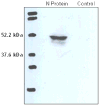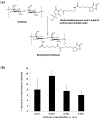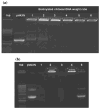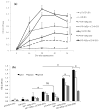Dendritic cell targeted chitosan nanoparticles for nasal DNA immunization against SARS CoV nucleocapsid protein
- PMID: 22356166
- PMCID: PMC3322645
- DOI: 10.1021/mp200553x
Dendritic cell targeted chitosan nanoparticles for nasal DNA immunization against SARS CoV nucleocapsid protein
Abstract
This work investigates the formulation and in vivo efficacy of dendritic cell (DC) targeted plasmid DNA loaded biotinylated chitosan nanoparticles for nasal immunization against nucleocapsid (N) protein of severe acute respiratory syndrome coronavirus (SARS-CoV) as antigen. The induction of antigen-specific mucosal and systemic immune response at the site of virus entry is a major challenge for vaccine design. Here, we designed a strategy for noninvasive receptor mediated gene delivery to nasal resident DCs. The pDNA loaded biotinylated chitosan nanoparticles were prepared using a complex coacervation process and characterized for size, shape, surface charge, plasmid DNA loading and protection against nuclease digestion. The pDNA loaded biotinylated chitosan nanoparticles were targeted with bifunctional fusion protein (bfFp) vector for achieving DC selective targeting. The bfFp is a recombinant fusion protein consisting of truncated core-streptavidin fused with anti-DEC-205 single chain antibody (scFv). The core-streptavidin arm of fusion protein binds with biotinylated nanoparticles, while anti-DEC-205 scFv imparts targeting specificity to DC DEC-205 receptor. We demonstrate that intranasal administration of bfFp targeted formulations along with anti-CD40 DC maturation stimuli enhanced magnitude of mucosal IgA as well as systemic IgG against N protein. The strategy led to the detection of augmented levels of N protein specific systemic IgG and nasal IgA antibodies. However, following intranasal delivery of naked pDNA no mucosal and systemic immune responses were detected. A parallel comparison of targeted formulations using intramuscular and intranasal routes showed that the intramuscular route is superior for induction of systemic IgG responses compared with the intranasal route. Our results suggest that targeted pDNA delivery through a noninvasive intranasal route can be a strategy for designing low-dose vaccines.
Figures







Similar articles
-
Plasmid DNA loaded chitosan nanoparticles for nasal mucosal immunization against hepatitis B.Int J Pharm. 2008 Apr 16;354(1-2):235-41. doi: 10.1016/j.ijpharm.2007.11.027. Epub 2007 Nov 22. Int J Pharm. 2008. PMID: 18182259
-
Enhanced induction of SARS-CoV nucleocapsid protein-specific immune response using DNA vaccination followed by adenovirus boosting in BALB/c mice.Intervirology. 2006;49(5):307-18. doi: 10.1159/000094247. Epub 2006 Jun 29. Intervirology. 2006. PMID: 16809936 Free PMC article.
-
Induction of mucosal immune responses and protection of cattle against direct-contact challenge by intranasal delivery with foot-and-mouth disease virus antigen mediated by nanoparticles.Int J Nanomedicine. 2014 Dec 2;9:5603-18. doi: 10.2147/IJN.S72318. eCollection 2014. Int J Nanomedicine. 2014. PMID: 25506214 Free PMC article.
-
A simple approach for enhanced immune response using engineered dendritic cell targeted nanoparticles.Vaccine. 2012 Nov 26;30(50):7292-9. doi: 10.1016/j.vaccine.2012.09.036. Epub 2012 Sep 26. Vaccine. 2012. PMID: 23022399
-
Comparative immunization in BALB/c mice with recombinant replication-defective adenovirus vector and DNA plasmid expressing a SARS-CoV nucleocapsid protein gene.Cell Mol Immunol. 2006 Dec;3(6):459-65. Cell Mol Immunol. 2006. PMID: 17257500
Cited by
-
Biopolymer-based Carriers for DNA Vaccine Design.Angew Chem Int Ed Engl. 2021 Jun 7;60(24):13225-13243. doi: 10.1002/anie.202010282. Epub 2021 Jan 7. Angew Chem Int Ed Engl. 2021. PMID: 32893932 Free PMC article. Review.
-
Mucosal Vaccines, Sterilizing Immunity, and the Future of SARS-CoV-2 Virulence.Viruses. 2022 Jan 19;14(2):187. doi: 10.3390/v14020187. Viruses. 2022. PMID: 35215783 Free PMC article. Review.
-
Current advances and challenges in COVID-19 vaccine development: from conventional vaccines to next-generation vaccine platforms.Mol Biol Rep. 2022 Jun;49(6):4943-4957. doi: 10.1007/s11033-022-07132-7. Epub 2022 Mar 2. Mol Biol Rep. 2022. PMID: 35235159 Free PMC article. Review.
-
Advances in the polymeric delivery of nucleic acid vaccines.Theranostics. 2022 May 13;12(9):4081-4109. doi: 10.7150/thno.70853. eCollection 2022. Theranostics. 2022. PMID: 35673570 Free PMC article. Review.
-
Oligonucleotide therapy: An emerging focus area for drug delivery in chronic inflammatory respiratory diseases.Chem Biol Interact. 2019 Aug 1;308:206-215. doi: 10.1016/j.cbi.2019.05.028. Epub 2019 May 25. Chem Biol Interact. 2019. PMID: 31136735 Free PMC article. Review.
References
-
- Steinman RM. Dendritic Cells In Vivo: A Key Target for a New Vaccine Science. Immunity. 2008;29(3):319–324. - PubMed
-
- Tacken PJ, De Vries IJM, Torensma R, Figdor CG. Dendritic-cell immunotherapy: From ex vivo loading to in vivo targeting. Nat Rev Immunol. 2007;7(10):790–802. - PubMed
-
- Keler T, He L, Ramakrishna V, Champion B. Antibody-targeted vaccines. Oncogene. 2007;26(25):3758–3767. - PubMed
-
- Proudfoot O, Apostolopoulos V, Pietersz GA. Receptor-mediated delivery of antigens to dendritic cells: Anticancer applications. Mol Pharm. 2007;4(1):58–72. - PubMed
-
- Inaba I, Swiggard WJ, Inaba M, Meltzer J, Mirza A, Sasagawa T, Nussenzweig MC, Steinman RM. Tissue distribution of the DEC-205 protein that is detected by the monoclonal antibody NLDC-145 I. Expression on dendritic cells and other subsets of mouse leukocytes. Cell Immunol. 1995;163(1):148–156. - PubMed
Publication types
MeSH terms
Substances
Grants and funding
LinkOut - more resources
Full Text Sources
Research Materials
Miscellaneous

